Widescreen Weekend 2008 Program
|
Read more
at in70mm.com The 70mm Newsletter |
| Text by: Tony Earnshaw (NMM) & Thomas Hauerslev | Date: 13 March 2007 |
Friday 7 March 2008 |
|
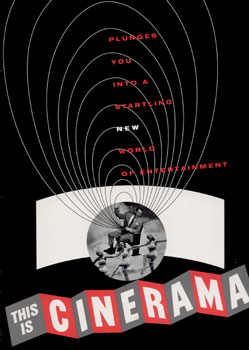 Developed by Fred Waller. Narrated by Lowell Thomas. Supervised by Michael Todd and Michael Todd Jr. Produced by Merian C. Cooper and Robert L. Bendick. Music by Cinerama Philharmonic Orchestra. Cinematography by Harry Squire. Print: National Media Museum Academy Award Nominated: Best Music, Scoring of a Dramatic or Comedy Picture This is the original Cinerama feature which launched the widescreen era, here presented in a recently struck print in the original three-strip format, with seven-track stereo sound. There is no narrative, merely a variety of 'attractions': the famous rollercoaster ride is followed by a series of musical and travelogue episodes culminating in an aerial tour of America. More than a technological curio, it's a document of its era. What is Cinerama? Cinerama is a very complicated projection process with three projectors electronically locked together, showing three 35mm films side by side on the same curved screen, at the same time. Cinerama, very effectively creates an illusion of reality, by photographing an extreme wide-angle picture on three strips of film. Cinerama is shown on a large curved screen like Pictureville's. The curve is defined as being 146 degrees of a circle. The screen is geometrically the same size as the human eye, which when a spectator sits somewhere close to the center of the circle, looking at the middle of the screen, he’s having A First Person Experience. He’s having the sensation he is there, right in the middle of the action. The audience will feel a sensation of participation. Why does a Cinerama screen have to be deeply curved? ”If you photograph a cavalry of horses coming toward you and sweeping past, using conventional narrow angle lenses (and this includes CinemaScope), the camera never sees the sides of the horses. If this is now projected on a screen, even a wide curved one, wrapped around the audience, as the horses go off the screen, they all turn facing you and gallop sideways. This is a subtle effect, but the fact that you never see the sides of objects, destroys the participation effect - the sense of being in the middle of the action.” Brian O'Brien, Jr. about Cinerama. |
More
in 70mm reading: Widescreen Weekend 2008 • Gallery: 2008 • Gallery: Grenhalgh • Gallery: Rayton • WSW Home • Through the Years • The Best of WSW • Academy of the WSW • Creating the WSW • Planning the WSW • Projecting the WSW • Home of CINERAMA • Projecting CINERAMA Internet link: Cinerama Adventure C.A. Productions 261 W. Verdugo Ave., #D Burbank, CA 91502 Phone: (818)843-1865 |
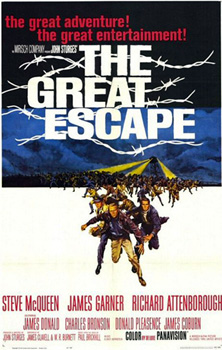 13:30
- 16:23
“The Great Escape”
(2:52) (+ intermission).
Filmed in:
35mm, 24 frames per second.
Principal photography in: Panavision. Presented:
On the flat screen in a new 2K digital.
Sound: Fully uncompressed 6 channel 5.1 sound.
Aspect ratio: 2,39;1. Country of origin: USA. Production year:
1963
World Premiere: 15.04.1963, USA. 13:30
- 16:23
“The Great Escape”
(2:52) (+ intermission).
Filmed in:
35mm, 24 frames per second.
Principal photography in: Panavision. Presented:
On the flat screen in a new 2K digital.
Sound: Fully uncompressed 6 channel 5.1 sound.
Aspect ratio: 2,39;1. Country of origin: USA. Production year:
1963
World Premiere: 15.04.1963, USA.Produced and Directed by John Sturges. Written by James Clavell. Music by Elmer Bernstein. Cinematography by Daniel L. Fapp. Edited by Ferris Webster Steve McQueen (Capt. Hilts "The Cooler King"), James Garner (Flight Lt. Hendley "The Scrounger"), Richard Attenborough (Squadron Leader Roger Bartlett "Big X"), Charles Bronson (Flight Lt. Danny Velinski "The Tunnel King"), Donald Pleasence (Flight Lt. Colin Blythe "The Forger"), James Coburn (Flying Officer Louis Sedgwick "The Manufacturer") An immediate classic on its release, this timeless tale of courage in adversity remains notable for the emergence of Steve McQueen as a bonafide movie star. Based in part on Paul Brickhill’s book on the mass escape from a German prison camp during WWII, the film goes off into flights of Hollywood fancy as McQueen heads for the Swiss border on a stole German motorcycle. But it’s the sheer verve and machismo that drives the story forward. Academy Award Nominated: Best Film Editing historyonthenet.com + Stalag Luft 3 |
|
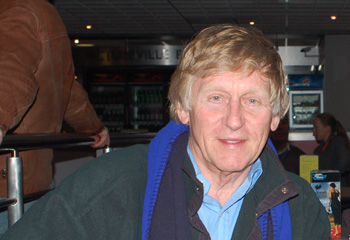 Special Guests Special GuestsJohn Layton in Pictureville foyer. Image by Thomas Hauerslev Special appearance by John Leyton, who starred in "The Great Escape" as Flight Lieutenant William Dickes "The Tunneller" John Leyton was born Feb. 17th 1939 in Frinton-on-Sea, Essex, England. His parents already had connections with show business, his father owning cinemas and theatres and his mother acting on the London stage under the name of 'Babs Walters'. Although having experienced phenomenal success as a pop star, John felt far more at home as an actor than a singer. He returned to acting and his motion picture debut came when cast alongside Charles Bronson, Steve McQueen and Richard Attenborough as 'WILLIE THE TUNNEL KING' in the classic true war movie "The Great Escape". His performance prompted 20th Century Fox to put him under contract and next came a starring role in "Guns at Batasi" with Richard Attenborough and Mia Farrow. For this performance he was nominated by American Cinema Editors Inc. for 'BEST PERFORMANCE BY AN ACTOR'. This was followed by "Von Ryan's Express" with Frank Sinatra and Trevor Howard. John Layton also appeared in the large format film "Krakatoa" John Layton's web site |
|
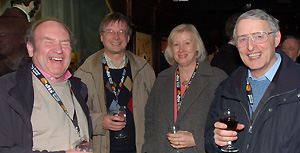 17:00 Reception for weekend delegates in the Kodak Gallery 17:00 Reception for weekend delegates in the Kodak GalleryImages from the 2008 reception |
|
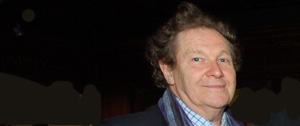 Lecture: Movie Sound Formats Lecture: Movie Sound Formats18:30 "Optical Sound on 35mm Film" Lecture by Dion Hanson - a Power Point presentation showing the way optical sound has developed over the years. The original show was to explain to new projectionists how the release print has changed over time. Dion Hanson is no stranger to Picturevillle's audience, but here's his quick resume. My life in cinemas began in 1960 as a rewind boy in my local cinema, The Crescent Pontefract, whilst at school. Did relief work around the country during the summer holidays. Went to Huddersfield Polytechnic to study Electrical Engineering. After that went to work for Westrex in Leeds finishing up as supervisor in 1975. Left them to work for Rank Leisure as installation engineer. Installing many of the first Dolby CP50 units around the country and left them to join Dolby itself around 1984. Where I supervised many installations around the world and trained hundreds of engineers how to install the various processors. Started working freelance in 2001 doing installations and supervising special screenings as well as checking out equipment in such venues as film laboratories. |
|
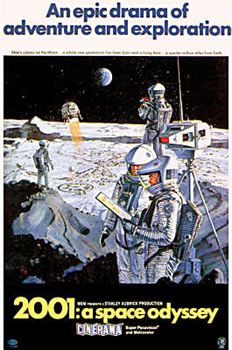 19:30
- 21:59
“2001: A Space Odyssey”
(2:29) + intermission.
Filmed in:
65mm, 24 frames per second.
Principal photography in: Super Panavision 70. Presented:
On the curved screen with 6-track Dolby Stereo, format 43.
Aspect ratio: 2,21;1. Country of origin: USA. Production year:
1968.
World Premiere: 02.04.1968 The Uptown Theatre, Washington, USA. 19:30
- 21:59
“2001: A Space Odyssey”
(2:29) + intermission.
Filmed in:
65mm, 24 frames per second.
Principal photography in: Super Panavision 70. Presented:
On the curved screen with 6-track Dolby Stereo, format 43.
Aspect ratio: 2,21;1. Country of origin: USA. Production year:
1968.
World Premiere: 02.04.1968 The Uptown Theatre, Washington, USA. Produced and directed by Stanley Kubrick. Cinematography by Geoffrey Unsworth. Edited by Ray Lovejoy. Douglas Trumbull (special photographic effects supervisor). Keir Dullea (Dr. Dave Bowman), Gary Lockwood (Dr. Frank Poole), William Sylvester (Dr. Heywood R. Floyd), Daniel Richter (Moon-Watcher), Douglas Rain (HAL 9000 (voice)) A film deserving of the description “ground-breaking”, Kubrick’s "2001: A Space Odyssey" remains one of the all-time classics of science-fiction cinema. It is presented during WSW in its original Cinerama format in a restored 70mm print with sixtrack magnetic stereo sound on the curved Pictureville screen. Oscar: Special Visual Effects, Stanley Kubrick Academy Award Nominated: Best Art Direction-Set Decoration, Best Director, Best Writing, Story and Screenplay - Written Directly for the Screen Full credits The CD Soundtrack A Roadshow Odyssey Restoring the soundtrack "2001" and the curved screen The Original Reserved Seat Engagements Of "2001: A Space Odyssey" Christiane Kubrick's Website Creating special effects for "2001" Kubrick Films and old Christiane Kubrick web site hosted by Warner Brothers. Warner Brothers' 6 year old "2001" web site 9th Anniversary of Stanley Kubrick's passing 40th Anniversary Screening of the films premiere 80th Anniversary screening on the occasion of Stanley Kubrick's birth (26 July 1928 - 7 March 1999) Introduced by Jan Harlan |
|
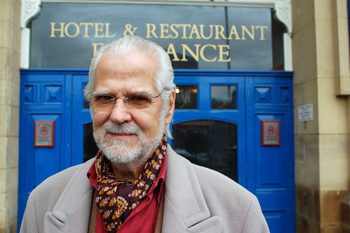 Jan Harlan in conversation with Thomas Hauerslev Jan Harlan in conversation with Thomas HauerslevJan Harlan 08.03.2008. Image by Thomas Hauerslev Jan Harlan is the brother of Christiane Kubrick, Stanley Kubrick's widow. He acted as Kubrick's Executive Producer for more than 30 years "Eyes Wide Shut" (1999), "Full Metal Jacket" (1987), "The Shining" (1980), "Barry Lyndon" (1975)) and as Assistant to the Producer for "A Clockwork Orange" (1971)). Harlan was also Executive Producer for Steven Spielberg's "Artificial Intelligence: AI" (2001), a collaboration between Spielberg and Kubrick. Harlan directed "Stanley Kubrick: A Life in Pictures" (2001). He has three sons, Manuel, Dominic and Ben. He is married to Maria. Producer: What Is Out There? (2007) (V) (producer) O Lucky Malcom! (2006) (producer) Artificial Intelligence: AI (2001) (executive producer) Stanley Kubrick: A Life in Pictures (2001) (producer) Eyes Wide Shut (1999) (executive producer) Full Metal Jacket (1987) (executive producer) The Shining (1980) (executive producer) Barry Lyndon (1975) (executive producer) Director: O Lucky Malcom! (2006) Stanley Kubrick: A Life in Pictures (2001) |
|
Saturday 8 March 2007 |
|
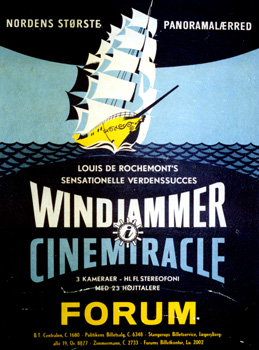 10:00 – 12:22 “Windjammer”
(2:22) + intermission.
Filmed in:
3x35mm 6 perforations, 26 frames per second.
Principal photography in: Cinemiracle. Presented:
On the curve in 3-strip Cinemiracle with 7-track magnetic stereo.
Aspect ratio: 146°. Country of origin: USA. Production year:
1958.
World Premiere: 09.04.1958 The Chinese Theatre, Los Angeles, USA. 10:00 – 12:22 “Windjammer”
(2:22) + intermission.
Filmed in:
3x35mm 6 perforations, 26 frames per second.
Principal photography in: Cinemiracle. Presented:
On the curve in 3-strip Cinemiracle with 7-track magnetic stereo.
Aspect ratio: 146°. Country of origin: USA. Production year:
1958.
World Premiere: 09.04.1958 The Chinese Theatre, Los Angeles, USA.Directed by Bill Colleran & Louis De Rochemont III. Produced by Louis De Rochemont III. Original Music by Morton Gould. Cinematography by Joseph C. Brun & Gayne Rescher. Film edited by Film Editing by Peter Ratkevich. Pablo Casals (Himself), Yngvar Kjelstrup (Captain), Lasse Kolstad (Third assistant bosun), Sven Libaek (Cadet #35), Harald Tusberg (Cadet #32) Print: National Media Museum The 50th anniversary of the release of this film shot in Cinemiracle. Widescreen fans love it. It’s a great cultural experience as a group of cadets on a training exercise take the SS Christian Radich from Oslo, across the Atlantic and on to New York. Featuring great and much sought-after music. Cast and Credits + Transcript 50th Anniversary Screening |
|
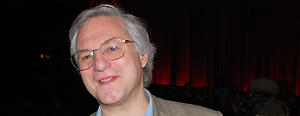 "The Bigger Picture" "The Bigger Picture"a very personal overview of the history of movie presentation 13:30 - 14:30 Illustrated lecture by Tony Sloman. 45-60 min Tony Sloman could accurately be described as a "Human Movie Database". His recall of the most obscure incident, character, director, or even musical theme of some long-forgotten film is phenomenal. His knowledge of film formats, aspect ratios and technical data is equally as impressive. He is involved with all aspects of film production. Academy of the Widescreen Weekend |
|
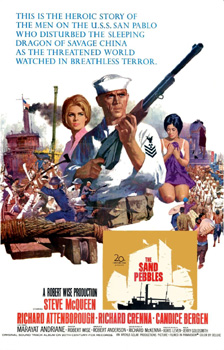 14:45
- 17:47
“The
Sand Pebbles”
(3:02) + intermission.
Filmed in:
35mm anamorphic, 24 frames per second.
Principal photography in: Panavision. Presented:
On the flat screen in a new 35mm Dolby Digital print.
Aspect ratio: 2,39:1. Country of origin: USA. Production year:
1966.
World Premiere: 20.12.1966 The
Rivoli Theatre, New York, USA. 14:45
- 17:47
“The
Sand Pebbles”
(3:02) + intermission.
Filmed in:
35mm anamorphic, 24 frames per second.
Principal photography in: Panavision. Presented:
On the flat screen in a new 35mm Dolby Digital print.
Aspect ratio: 2,39:1. Country of origin: USA. Production year:
1966.
World Premiere: 20.12.1966 The
Rivoli Theatre, New York, USA.
Directed by Robert Wise. Written by Robert Anderson. Produced by Charles H. Maguire. Original Music by Jerry Goldsmith. Cinematography by Joseph MacDonald. Edited by William Reynolds Steve McQueen (Holman), Richard Attenborough (Frenchy), Richard Crenna (Collins), Candice Bergen (Shirley), Mako (Po-han) Print: 20th Century Fox In between "The Sound of Music" and Star!, Robert Wise delivered a classic war epic set in 1920s China. The Sand Pebbles boasts an Oscar-nominated performance by Steve McQueen’s as engineer Jake Holman, who upsets the status quo on board the US gunboat San Pablo. Remastered digitally at the highest resolution, this new 35mm print receives its UK premiere. Academy Award Nominated: Best Actor in a Leading Role Best Actor in a Supporting Role Best Art Direction-Set Decoration, Color Best Cinematography, Color Best Film Editing Best Music, Original Music Score Best Picture Best Sound See Crispin Garcia's The Sand Pebbles web site |
|
|
From
digitalcontentproducer.com Restoration of “The Sand Pebbles”, overseen by Twentieth Century Fox VP of Asset Management and Film Preservation Schawn Belston, was completed by Ascent Media Group (AMG). The workflow started with a complete evaluation, inspection and physical repair of the original negative at Cinetech (Ascent Media’s film restoration and full service motion picture laboratory). Next, a series of photo-chemical direct prints were struck from the original in order to better identify the digital restoration needs followed by a 4K, 10-bit pin registered scan on Ascent Media’s Northlight scanners. Digital restoration was performed at full 4K resolution at AMG’s Digital Media Data Center (DMDC) using Quantel’s integrated iQ digital intermediate and Pablo color correction systems. After final approval of the color and restoration, the files were recorded back out to a 4K negative. Cinetech then manufactured the composite 35mm check print using an audio track restored by Ascent Media’s POP sound division. POP processed out the hisses and ticks, time-aligned the original 70mm version 6-track to the reference picture and conformed and remixed the music using the original interlocked 6-track and dual 3-track 35mm magnetic scores. Effects enhancements were created from the original sound design, as well as a new Dolby LTRT discreet 5.1 surround mix using newly created subwoofer, equalization, and spatializing technique. 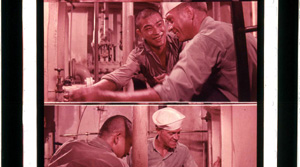 Faded
70mm frame Faded
70mm frameFrom hometheatershack.com: “The Sand Pebbles” was a Fox film and thus 'Color by De Luxe'. What this meant back in 1966 was that all prints (including the blow up 70mm Roadshow copy) were struck directly from the 35mm Panavision camera negative. We're talking three to four hundred prints struck from the original which really wore it out. In 2005, Fox decided to use "The Sand Pebbles" as their first 4K restoration. The extremely faded and worn camera negative was scanned into the digital machine at this resolution. Then a frame at a time (at 182 minutes) was fixed which is why it took so long. The end results are outstanding and as good as it looked back in 1966. |
|
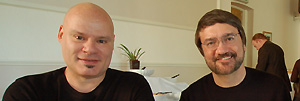 "Making of HTWWW" seminar "Making of HTWWW" seminarHosted by David Strohmaier & Randy Gitsch 18:00 - 19:00 Randy Gitsch and David Strohmaier "Making of HTWWW" seminar / rough cut (Digital Video 4 x 3 Projection) 1 hour hosted by Dave and Randy. (Randy & I will introduce several start and stop video segments and talk between them, this will be a "rough cut" of a 40 minute documentary for Warner Home Video. ) This will cover the origins of How The West Was Won beginning with a 1923 pageant, the seven part Life Magazine series, the popular Bing Crosby record album, and through the gigantic production that became the highest grossing picture made in the year 1962. This would feature rare audio recordings of Henry Hathaway and the three ASC cameramen who shot the film talking about the difficulties of the Cinerama filming. On screen will be rare behind the scenes stories and never before seen interviews with the actors, producer and editors. An added bonus is an unusual look at the films spectacular locations back then and how they look today after 45 years. We would briefly discuss the remastering of "How the West Was Won" and what the Warner Brothers plan is for SmileBox deluxe collectors edition. We would also spend the last 15 minutes of the hour getting feedback on what the audience would like to see included in the final cut documentary. This presentation will begin with a the showing of the 6 minute 3-panel trailer for "How the West Was Won" on the curved screen. Bonus: A little 3 minute video of the Duncan and Tony running "How the West Was Won" in 2007. |
|
 Produced by Saul Chaplin. Original Music by Lennie Hayton. Cinematography by Ernest Laszlo. Film Editing by William Reynolds. Production Design by Boris Leven. Directed by Robert Wise. Julie Andrews (Gertrude Lawrence), Richard Crenna (Richard Aldrich, Producer ), Michael Craig (Sir Anthony Spencer), Daniel Massey (Noel Coward), Robert Reed (Charles Fraser), Bruce Forsyth (Arthur Lawrence) Print: 20th Century Fox Academy Award Nominated: Best Actor in a Supporting Role Best Art Direction-Set Decoration Best Cinematography Best Costume Design Best Music, Original Song Best Music, Score of a Musical Picture (Original or Adaptation) Best Sound 40th Anniversay Screening What is Todd-AO? "TODD-AO 70mm film, plus the TODD-AO special camera, plus the TODD-AO newly developed 6 channel high fidelity magnetic sound, plus the TODD-AO "all purpose" 70mm projector and the great arched TODD-AO screen equal the most revolutionary of all screen inventions, with clarity of perspective, detail and color reproduction never before achieved. As a result, with TODD-AO, audience participation now has its fullest and truest expression. Todd-AO is the dream of Michael Todd, plus the technical skills of the American Optical Company whose research staff headed by Dr. Brian O'Brien, jointly succeeded in developing "a motion picture system that would photograph action in a very wide angle....with one camera....on one strip of film....to be projected from a single projector....on a very wide screen....with a quality so perfect that the audience would be part of the action, not just passive spectators. |
|
Sunday 9 March 2008 |
|
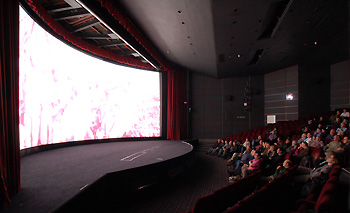 10:00 – 12:30 Cineramacana including the odd surprise and the Academy of the
Widescreen Weekend presentation. 10:00 – 12:30 Cineramacana including the odd surprise and the Academy of the
Widescreen Weekend presentation.One of the most popular events of the Widescreen Weekend and a great way to wake up on a Sunday morning, Cineramacana brings together all those little bits and pieces that lie around in people’s cupboards or on dusty shelves in archives and seldom see the light of a projector. Over the years there have been some magical discoveries and nobody knows what will be shown until the event itself. Even then there is the occasional surprise. And there will just be time for the traditional Audience on stage photograph of all the WW delegates. |
|
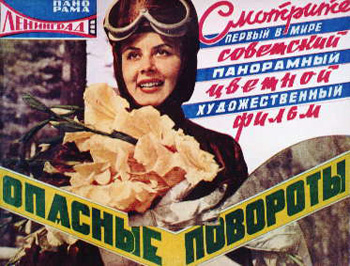 Kinopanorama
during Cineramacana Kinopanorama
during CineramacanaI am pleased to announce that I have authorised Mr David Strohmaier of "The Cinerama Adventure" to screen our two-reel 3-panel restoration footage of "Opasniye Povoroty" (1961) and the black & white newsreel of "Moscow Cinema Chronicle Number Six" (1958) at this years' Bradford Widescreen Festival. This is the premier screening of either film in the UK, not to mention the first screening of any 3-panel Kinopanorama print at Bradford in some 11-years. |
|
 Screentalk with Kenneth Branagh Screentalk with Kenneth BranaghKenneth Branagh in Copenhagen. Photo by Thomas Hauerslev Head of Cinema, Tony Earnshaw will be doing a one hour screentalk with Kenneth Branagh on stage discussing his career, before "Hamlet" This event has already sold out. |
|
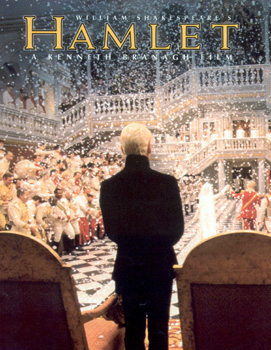 13:30
- 17:32
“Hamlet”
(4:02) + intermission.
Filmed in:
65mm, 24 frames per second.
Principal photography in: Panavision System 65. Presented:
On the flat screen with 6-track Dolby Stereo, format 43.
Aspect ratio: 2,21;1. Country of origin: USA. Production year:
1996.
World Premiere: 25.12.1996 The Ziegfeld Theatre, New York, USA. 13:30
- 17:32
“Hamlet”
(4:02) + intermission.
Filmed in:
65mm, 24 frames per second.
Principal photography in: Panavision System 65. Presented:
On the flat screen with 6-track Dolby Stereo, format 43.
Aspect ratio: 2,21;1. Country of origin: USA. Production year:
1996.
World Premiere: 25.12.1996 The Ziegfeld Theatre, New York, USA. Produced by David Barron. Original Music by Patrick Doyle. Cinematography by Alex Thomson. Edited by Neil Farrell. Directed by Kenneth Branagh. Kenneth Branagh (Hamlet), Julie Christie (Gertrude), Charlton Heston (Player King), Derek Jacobi (Claudius), Kate Winslet (Ophelia) Academy Award Nominated: Best Art Direction-Set Decoration Best Costume Design Best Music, Original Dramatic Score Best Writing, Screenplay Based on Material from Another Medium "Hamlet" 1996 press release "Hamlet" reviews "Hamlet" cast/credits |
|
 18:00
- 19:45
“Honeymoon“
/ "Luna de Miel" (1:45).
Filmed in: 35mm 8 perforations, 24 frames per second.
Principal photography in: Technirama. Presented:
On the flat screen in a new restored 35mm print. Aspect ratio:
2,39:1. Country of origin: United Kingdom and Spain. Production year:
1959.
World Premiere: 29.03.1959, Spain 18:00
- 19:45
“Honeymoon“
/ "Luna de Miel" (1:45).
Filmed in: 35mm 8 perforations, 24 frames per second.
Principal photography in: Technirama. Presented:
On the flat screen in a new restored 35mm print. Aspect ratio:
2,39:1. Country of origin: United Kingdom and Spain. Production year:
1959.
World Premiere: 29.03.1959, SpainDirected by Michael Powell. Written by Luis Escobar, Gregorio Martínez Sierra & Michael Powell. Produced by Cesáreo González and Michael Powell. Cinematography by Georges Périnal & Claude Renoir. Edited by Peter Taylor & John Victor-Smith. Anthony Steel (Kit Kelly), Ludmilla Tchérina (Anna), Antonio (Antonio), Léonide Massine (Der Geist) Cannes Film Festival Technical Grand Prize Nominated Golden Palm |
|
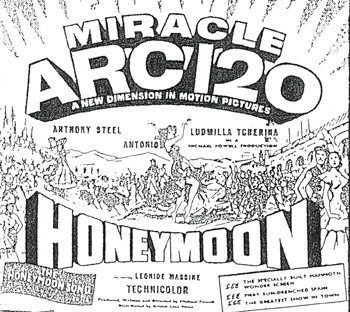 Introduced by Charles Doble, restorer of the film.
From the
"Honeymoon" restoration
web site: Introduced by Charles Doble, restorer of the film.
From the
"Honeymoon" restoration
web site:The storyline is best summed up in this release, published at the time in 1959: "Ludmila Tcherina and Anthony Steel are on a fabulous honeymoon in sunny Spain. They are rich. They are happy. And then they meet the fiery Spanish dancer Antonio... When Antonio discovers the bride is a prima ballerina who has given up her career for marriage, he refuses to rest until he has persuaded her to dance again - as his partner. Wherever they drive in their gleaming silver convertible, they run into Antonio. On the road outside Santiago; in a fashionable bar in Madrid; at the caves of Grenada. Antonio conducts a captivating campaign. He persuades her to dance with him in his studio. He tempts her with his dancing feet; he lures her on with his mischievous eyes. He breathes into her ear that only she can dance the leading role in his latest production. He ignores the jealous husband. When the three meet in Madrid for the last time Antonio has apparently called off his campaign. Everything it seems, will be back to normal. The honeymooners are free to continue their world cruise. But there's still a twinkle in Antonio's eyes. For he is about to go with his dance company...on a world tour!" |
|
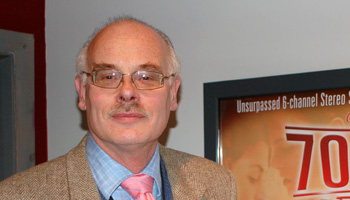 Charles
Doble in Pictureville foyer. Image by Thomas Hauerslev Charles
Doble in Pictureville foyer. Image by Thomas HauerslevIt was originally produced in stereo; a four track magnetic version. Visually, it was released in both Wonderama and Technirama. These were very new processes. One of these was an attempt to get over the problems of loss of focus where projection was onto large curved screens. This involved a complicated and heavy series of lenses mounted on the front of the 35mm projector. Each cell of the film was divided vertically into two halves. From a projection point of view it was a nightmare to get the two halves to meet seamlessly in the centre of the screen and at the same time, even with the largest projectors, the colossally heavy adaptor for the ARC 120 process caused uncontrollable picture shake. "Honeymoon" restoration notes "Honeymoon" in ARC-120 To Split or Not to Split |
|
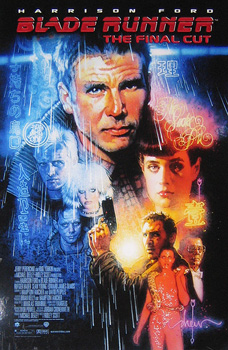 20:30
- 22:27
“Blade Runner - The Final Cut“ (1:57).
Filmed in: 35mm 4 perforation + special effects in 65mm 5 perforations, 24 frames per second.
Principal photography in: Panavision. Presented:
On the flat screen in a new digital 2K print.
Sound: Fully uncompressed 6 channel 5.1 sound. Aspect ratio: 2,39:1. Country of origin: USA. Production year:
1982.
World Premiere: 05.10.2007 New York,
USA 20:30
- 22:27
“Blade Runner - The Final Cut“ (1:57).
Filmed in: 35mm 4 perforation + special effects in 65mm 5 perforations, 24 frames per second.
Principal photography in: Panavision. Presented:
On the flat screen in a new digital 2K print.
Sound: Fully uncompressed 6 channel 5.1 sound. Aspect ratio: 2,39:1. Country of origin: USA. Production year:
1982.
World Premiere: 05.10.2007 New York,
USADirected by Ridley Scott. Written by Hampton Fancher and David Webb Peoples. Produced by Michael Deeley. Original Music by Vangelis. Cinematography by Jordan Cronenweth. Edited by Marsha Nakashima Harrison Ford (Rick Deckard), Rutger Hauer (Roy Batty), Sean Young (Rachael Edward James Olmos (Gaff), M. Emmet Walsh (Bryant), Daryl Hannah (Pris) Academy Awards Nominated: Oscar Best Art Direction-Set Decoration Best Effects, Visual Effects From: fandango.com: Harrison Ford stars as Rick Deckard, a retired cop in Los Angeles circa 2019. L.A. has become a pan-cultural dystopia of corporate advertising, pollution and flying automobiles, as well as replicants, human-like androids with short life spans built by the Tyrell Corporation for use in dangerous off-world colonization. Deckard's former job in the police department was as a talented blade runner, a euphemism for detectives that hunt down and assassinate rogue replicants. Called before his one-time superior (M. Emmett Walsh), Deckard is forced back into active duty. A quartet of replicants led by Roy Batty (Rutger Hauer) has escaped and headed to Earth, killing several humans in the process. After meeting with the eccentric Eldon Tyrell (Joe Turkel), creator of the replicants, Deckard finds and eliminates Zhora (Joanna Cassidy), one of his targets. Attacked by another replicant, Leon (Brion James), Deckard is about to be killed when he's saved by Rachael (Sean Young), Tyrell's assistant and a replicant who's unaware of her true nature. In the meantime, Batty and his replicant pleasure model lover, Pris (Darryl Hannah) use a dying inventor, J.F. Sebastian (William Sanderson) to get close to Tyrell and murder him. Deckard tracks the pair to Sebastian's, where a bloody and violent final confrontation between Deckard and Batty takes place on a skyscraper rooftop high above the city. |
|
Monday 10 March 2008 |
|
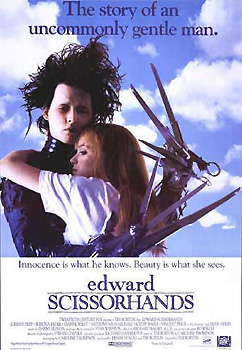 10:30
- 12:10 “Edward
Scissorhands“ (1:40).
Filmed in: 35mm 4 perforations, 24 frames per second.
Principal photography in: Panavision flat. Presented:
On the flat screen in a vintage 70mm blow-up print
with 6-track Dolby Stereo. Aspect ratio: 1,85:1. Country of origin:
USA. Production year:
1990.
World Premiere: 06.12.1990 Los Angeles,
USA 10:30
- 12:10 “Edward
Scissorhands“ (1:40).
Filmed in: 35mm 4 perforations, 24 frames per second.
Principal photography in: Panavision flat. Presented:
On the flat screen in a vintage 70mm blow-up print
with 6-track Dolby Stereo. Aspect ratio: 1,85:1. Country of origin:
USA. Production year:
1990.
World Premiere: 06.12.1990 Los Angeles,
USADirected and produced by Tim Burton. Written by Caroline Thompson. Music by Danny Elfman. Cinematography by Stefan Czapsky Johnny Depp (Edward Scissorhands), Winona Ryder (Kim), Dianne Wiest (Peg), Anthony Michael Hall (Jim), Kathy Baker (Joyce) and Vincent Price (The Inventor) Print: National Media Museum Academy Awards Nominated: Best Makeup An elderly inventor creates Edward, a living being, but dies before he can complete the hands. Edward is left alone – but with a dazzling array of knives and scissors at the ends of his arms. Peggy, the local Avon lady, finds him and brings him back to town. There he becomes a star at topiary and hairdressing. A very peculiar vision of small town America sees Tim Burton at his imaginative best. Edward is one of cinema’s great sympathetic characters. |
|
 12:24
- 14:00
“Brainstorm“ (1:36).
Filmed in: 35mm 4 perforations + 65mm 5 perforations, 24 frames per second.
Principal photography in: Super Panavision 70. Presented:
On the curved screen in a vintage Super Panavision 70 Dolby Stereo print. Aspect ratio: 2,21:1. Country of origin: USA. Production year:
1983.
World Premiere: 30.09.1983, The Ziegfeld Theatre, New York, USA 12:24
- 14:00
“Brainstorm“ (1:36).
Filmed in: 35mm 4 perforations + 65mm 5 perforations, 24 frames per second.
Principal photography in: Super Panavision 70. Presented:
On the curved screen in a vintage Super Panavision 70 Dolby Stereo print. Aspect ratio: 2,21:1. Country of origin: USA. Production year:
1983.
World Premiere: 30.09.1983, The Ziegfeld Theatre, New York, USADirected and produced by Douglas Trumbull. Original Music by James Horner. Cinematography by Richard Yuricich. Edited by Freeman A. Davies and Edward Warschilka Christopher Walken (Dr. Michael Anthony Brace), Natalie Wood (Karen Brace), Louise Fletcher (Dr. Lillian Reynolds), Cliff Robertson (Alex Terson), Jordan Christopher (Gordy Forbes), Donald Hotton (Landan Marks) Print from BFI, London With a machine that can put you into someone else’s experiences then this could be a great fun experience or learning device. But the military can also see some great potential. Partly shot in 70mm, this is a great ride and action movie from Douglas Trumbull, the man responsible for the effects in Kubrick’s 2001. 25th Anniversary Screening of "Brainstorm" From bluemountains.com: Lillian Reynolds (Louise Fletcher) and Michael Brace (Christopher Walken) head a team of scientists who have developed a device capable of recording and playing back sensory experience and even emotions and memories. Michael uses the device to effect a reconciliation with his estranged wife, Karen (Natalie Wood), by replaying to her his feelings about their relationship. Although their boss, Alex (Cliff Robertson) promises that their work will not be misused, it becomes clear to Lillian and Michael that the project is being sold to outsiders. Lillian suffers a fatal heart attack. While dying, she records her experience for Michael. Lillian’s death allows the take-over of the project by the military. Michael discovers that the device will be used for brainwashing and is banished from the project. Increasingly obsessed both with sabotaging the project and with experiencing the tape Lillian left for him, Michael conspires with Karen to destroy his work. |
|
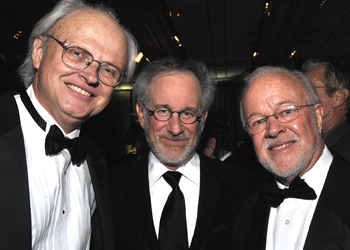 Douglas Trumbull Douglas Trumbull
Dennis Muren, Steven Spielberg and Douglas Trumbull at the recent Visual Effects Society Awards in Los Angeles. Picture curtsey Bill Kallay. "Brainstorm" directed by Douglas Trumbull Selected filmography as Director (films in 65mm): Leonardo's Dream (1989) Showscan Let's Go (1985) Showscan Brainstorm (1983) Big Ball (1983) Showscan New Magic (1983) Showscan Selected filmography as Special Effects Supervisor (films in 65mm): Blade Runner (1982) Star Trek: The Motion Picture (1979) Close Encounters of the Third Kind (1977) 2001: A Space Odyssey (1968) To the Moon and Beyond (1964) |
|
|
Go: back
- top -
back issues
- news index Updated 22-01-25 |
|
